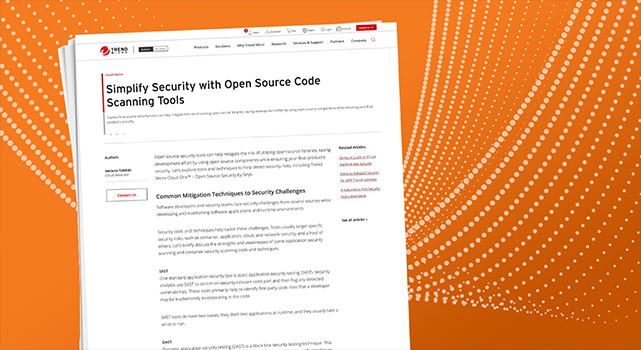Simplify Security with Open Source Code Scanning Tools Cloud Advocate


Open source security tools can help mitigate the risk of utilizing open source libraries, saving development effort by using open source components while ensuring your final product’s security. Let’s explore tools and techniques to help detect security risks, including Trend Micro Cloud One™ – Open Source Security by Snyk.
Common Mitigation Techniques to Security Challenges
Software developers and security teams face security challenges from several sources while developing and maintaining software applications and runtime environments.
Security tools and techniques help tackle these challenges. Tools usually target specific security risks, such as container, application, cloud, and network security, and a host of others. Let’s briefly discuss the strengths and weaknesses of some application security scanning and container security scanning tools and techniques.
One standard application security tool is static application security testing (SAST). Security analysts use SAST to zero-in on security-relevant code part and then flag any detected vulnerabilities. These tools primarily help to identify first party code risks that a developer may be inadvertently incorporating in the code.
SAST tools do have two issues: they don’t test applications at runtime, and they usually take a while to run.
Dynamic application security testing (DAST) is a black-box security testing technique. This technique tests an application from the outside at runtime, attacking the software like an actual attacker.
This security testing tool has an advantage over SAST in that it tests software at runtime. However, its main challenge is that its discoveries usually appear later in the development life cycle. For this reason, DAST doesn’t foster shifting left to test security at early software development stages.
As well, DAST doesn’t locate security issues particular to the code, such as hard-coded passwords. Also, a subject-matter expert still needs to verify its findings for them to be considered valid.
Interactive application security testing (IAST) works by assessing applications from the inside using software instrumentation, such as importing a library. It combines some pros of SAST and DAST as it reviews both static and running code, but like DAST, it doesn’t point to the problematic line of code. So, there’s a steep learning curve for deploying and reviewing results. Also, IAST must see an application vulnerability occur to identify it.
Runtime application self-protection (RASP) blocks (or flags) an attack as it happens. This real-time detection is vital when availability is a concern.
RASP defines a set of policies (or rules) that determine what to block or allow. However, you must correctly and meticulously define these rules, or you risk blocking legitimate traffic. RASP can be a helpful tool to add to your portfolio to protect applications at runtime.
Container security scanning helps security teams effectively manage container security by integrating container image scanning layer into the DevOps pipeline—known as DevSecOps. You can also provide policy-based admission control and continuous compliance scanning of your container-based deployment in both a pre-runtime and runtime state.
Open source software poses unique security risks as developers may inadvertently introduce vulnerabilities from using open source code and its dependencies and libraries. That’s why Trend Micro partnered with Snyk to develop Trend Micro Cloud One – Open Source Security by Snyk, which provides security insight, helping organizations identify, manage, and resolve open source code vulnerabilities. This tool replaces manual and error-prone security surveillance by automatically finding, prioritizing, and reporting risks and vulnerabilities in software applications’ open source dependencies.
How Does Open-Source Scanning Work?Trend Micro Cloud One – Open Source Security by Snyk helps tackle vulnerabilities with a few different approaches.
The service can integrate directly into the continuous integration and continuous delivery (CI/CD) pipeline or directly to the source control repository, like GitHub or Bitbucket. This integration enables it to track changes and monitor the application.
Snyk activates real-time scanning in the CI/CD pipeline, automatically detecting vulnerable components early in the development cycle. This early detection is an advantage as it prevents these vulnerabilities from reaching the production environment.
Some vulnerabilities don’t come directly from third-party libraries: They come from these libraries’ dependencies. This nested code makes it challenging for development and security teams to detect issues since they only know the libraries asked for via the manifest file and imported directly into the application. They may not be able to tell what or how many (potentially vulnerable) dependencies those libraries may have.
Trend Micro Cloud One – Open Source Security by Snyk provides a clearer picture of the chain of dependencies. This way, you can detect vulnerable components imported directly into the application and vulnerable dependencies hidden behind the directly imported elements.
Trend Micro Cloud One – Open Source Security by Snyk categorizes security challenges based on their severity level: critical, high, medium, and low. Its dashboard also uses charts to visually represent how your repositories’ risk profile evolves (see the image below). These classifications and graphs give you better insight into your security issues, as well as how to mitigate them.
Read More HERE




